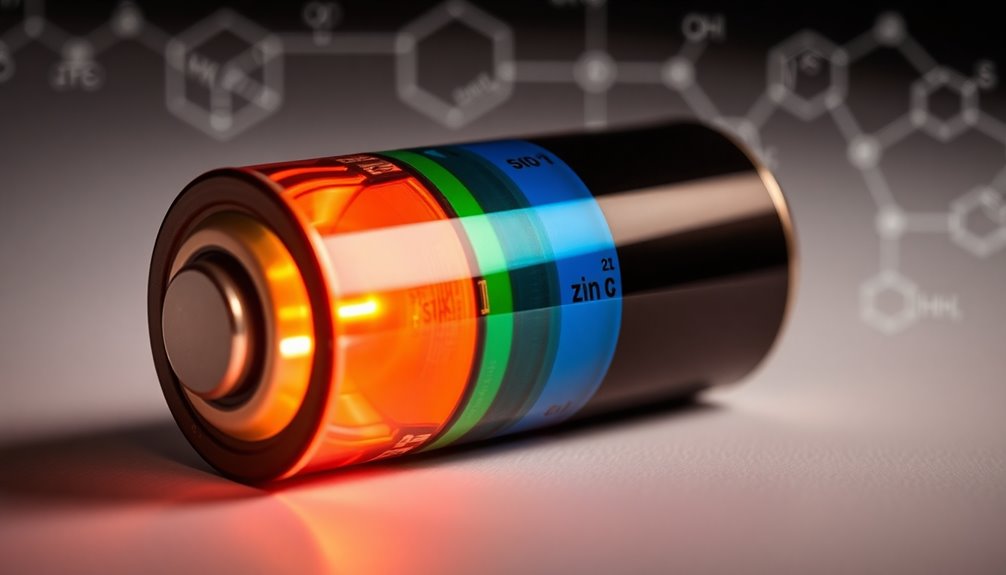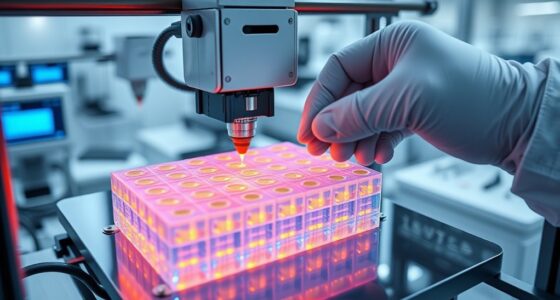Batteries work by converting chemical energy into electrical energy through electrochemical reactions. You have two electrodes: an anode (negative) and a cathode (positive). The electrolyte, a liquid or gel, allows ions to move between these electrodes. As the anode releases electrons, they flow to the cathode, generating electric current for your devices. In rechargeable batteries, this process is reversible, letting you use them multiple times. Factors like temperature and discharge rates can affect performance. Understanding these elements can enhance your battery usage. Stick around, and you'll discover even more about the fascinating world of battery technology!
Key Takeaways
- Batteries convert chemical energy into electrical energy through electrochemical reactions between the anode and cathode.
- The electrolyte facilitates ion movement, while the separator prevents short circuits between electrodes.
- During discharge, electrons flow from the anode to the cathode, generating electric current for devices.
- Rechargeable batteries can be cycled multiple times, whereas nonrechargeable batteries discharge irreversibly.
- Aging mechanisms and discharge rates significantly affect battery performance and lifespan, making proper care essential.
Battery Basics
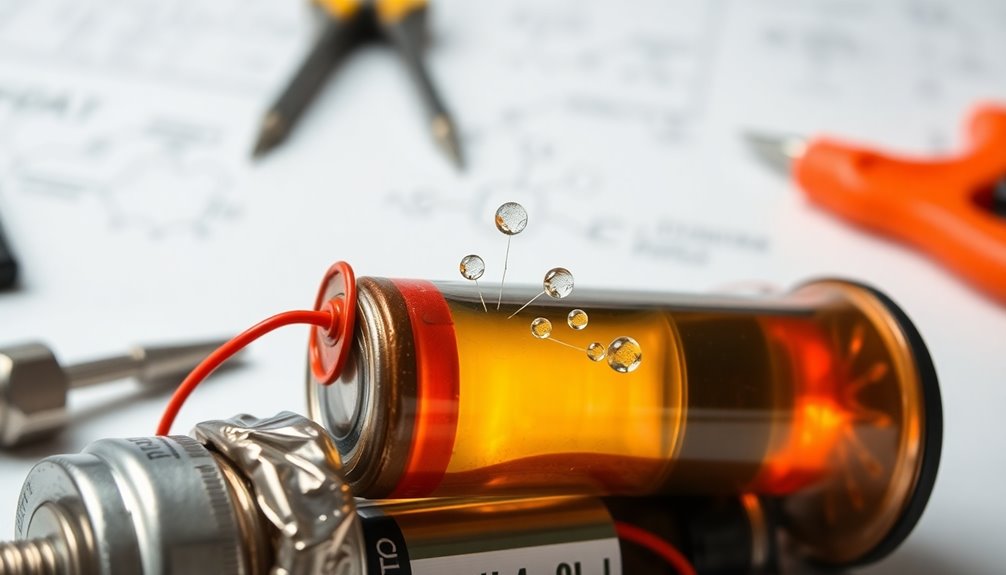
Batteries are fascinating devices that power our everyday gadgets. They consist of three main components: electrodes, an electrolyte, and a separator.
In a typical setup, the anode releases electrons while the cathode accepts them, creating a flow of electrical energy when you connect the battery to a circuit. This process enables rechargeable batteries, like nickel-metal hydride, to store and convert chemical energy into electrical energy to power devices.
As you use the battery, chemical reactions occur, gradually depleting the stored energy. Eventually, this leads to diminished power and a non-functional state once the battery is depleted.
Understanding these basics helps you appreciate the crucial role batteries play in your daily life.
Anatomy of a Battery
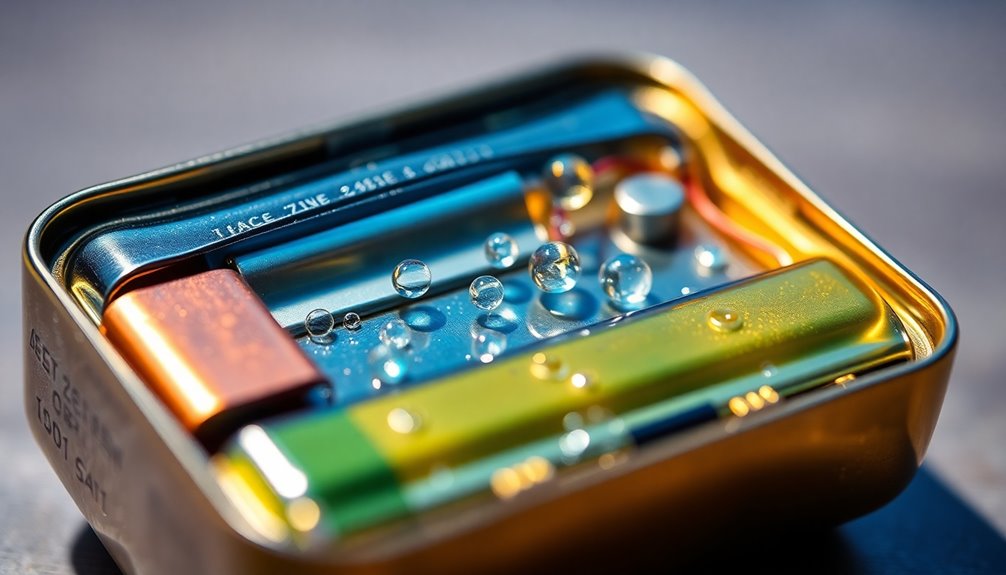
The intricate design of a battery reveals how its components work together to generate power. At its core, you'll find two electrodes: the anode and cathode. The anode acts as the negative electrode, releasing electrons during the chemical reaction, while the cathode serves as the positive electrode, accepting those electrons.
Surrounding these electrodes is the electrolyte, a liquid or gel-like substance filled with ions that facilitate the necessary chemical reactions. To keep everything functioning safely, the separator plays an essential role, preventing direct contact between the anode and cathode.
This separation is important, as it avoids short circuits that could damage the battery. Together, these elements convert chemical energy into electrical energy, powering your devices efficiently.
How Batteries Work

Understanding how batteries work is essential for grasping the technology behind your everyday devices.
Batteries include various types, such as alkaline and nickel-metal hydride (NiMH), which power cordless power tools and more. They convert chemical energy into electrical energy through electrochemical reactions between the electrodes and electrolyte.
When you connect a battery in a circuit, redox reactions occur: the anode releases electrons while the cathode accepts them, creating an electric current. The battery's components—the anode, cathode, electrolyte, and separator—work together to facilitate this current flow and prevent short circuits.
For rechargeable batteries, the charging process reverses these reactions, allowing you to restore energy by applying an external power source, enhancing their usability and efficiency.
Rechargeable vs. Nonrechargeable
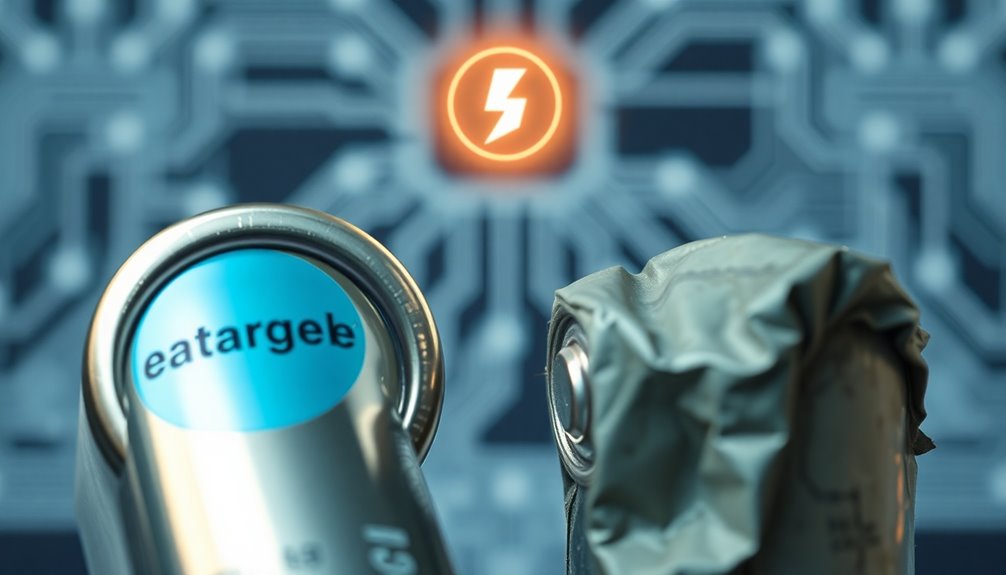
When it comes to powering your devices, the choice between rechargeable and nonrechargeable batteries can greatly impact both performance and convenience.
Nonrechargeable batteries, like alkaline types, are designed for single-use and discharge irreversibly, leaving you to replace them once they're drained.
On the other hand, rechargeable batteries, such as lithium-ion, allow you to feel free to recharge and reuse them, offering better long-term value. They typically have a higher capacity, providing longer usage times in your devices.
Plus, with a cycle life of 300 to 500 charges, they're more sustainable.
Keep in mind that nonrechargeable batteries contribute more to e-waste, making rechargeable options a smarter choice for the environment and your wallet, especially when you consider the batteries in use.
Charge Dynamics

As you explore how batteries function, it's essential to grasp the concept of charge dynamics.
Batteries create a separation of charges, with the anode becoming negatively charged and the cathode positively charged. This separation drives the flow of electricity when you connect the battery in a circuit. Electrons move from the anode to the cathode, generating an electric current that powers devices like LEDs.
However, as the battery discharges and the chemical reactions progress, the stored charge diminishes, reducing power output until the battery is depleted.
Factors like discharge rate and temperature also influence charge dynamics, with higher discharge rates potentially lowering overall capacity and efficiency.
Understanding these dynamics helps you troubleshoot circuits effectively.
Circuit Functionality
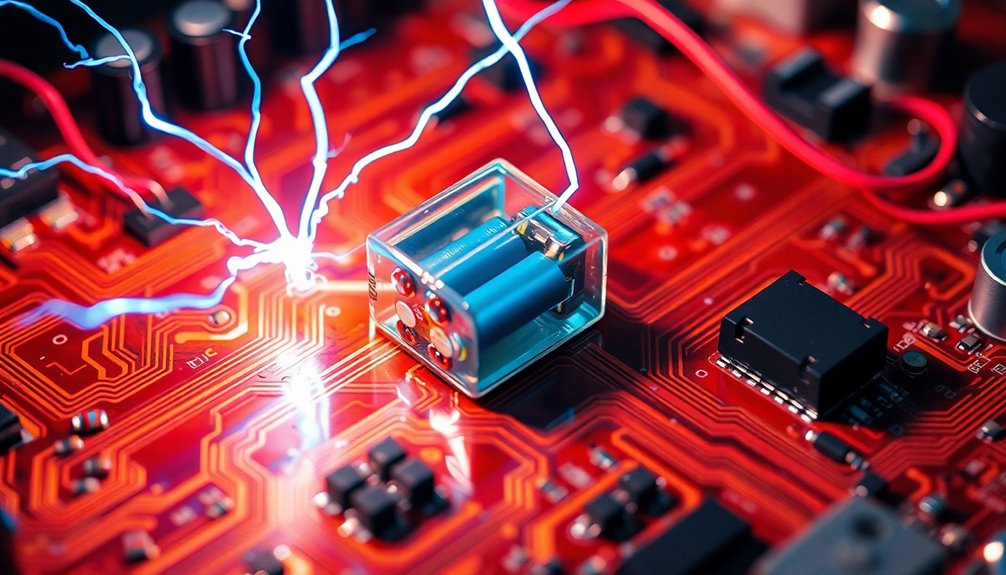
Circuit functionality hinges on the seamless connection of components, allowing electrons to flow efficiently from the battery. When you connect a battery, it creates a pathway for electrons to travel from the negative end to the positive end, much like sliding down a slide.
To guarantee your circuit operates correctly, keep these three points in mind:
- Correct LED Placement: An LED won't light up unless it's connected properly, enabling charge flow.
- Electron Movement: Electrons move due to the charge difference between the battery's electrodes.
- Battery Status: A weak battery can halt electron flow, so always check its charge to avoid circuit failure.
With these elements in place, your circuit will function effectively and deliver the desired results.
Troubleshooting Circuits
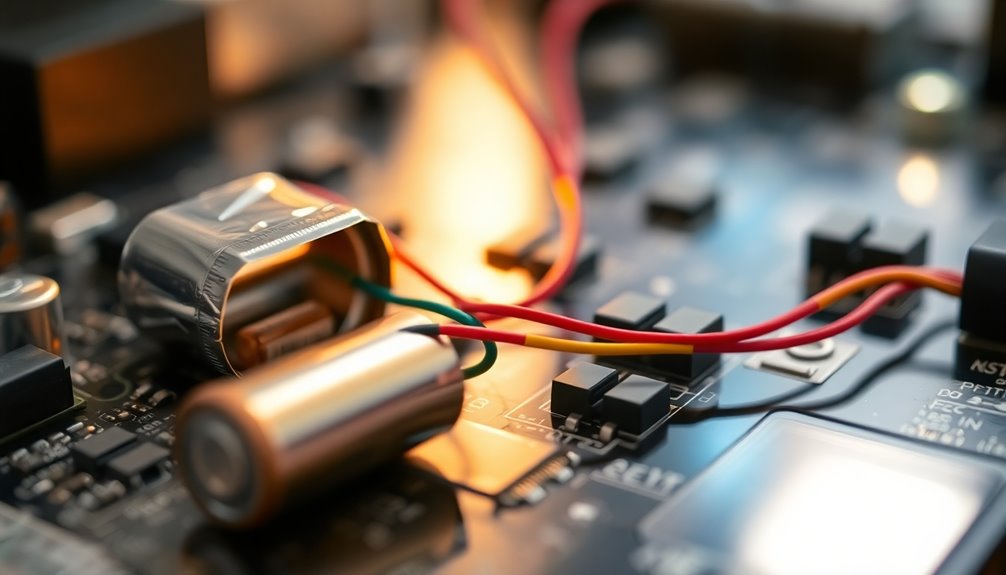
If you encounter a non-functional circuit, the first step is to check the batteries, since insufficient charge often leads to failure.
Use a multimeter to measure the battery voltage; this will help you spot if they're depleted. Next, verify the batteries are inserted correctly, as incorrect orientation can stop electricity flow.
Check the battery terminals for corrosion or dirt, since any buildup can disrupt the connection and impede circuit operation.
If you find old or depleted batteries, replace them with new ones, as primary batteries don't recharge.
Following these steps will help you quickly identify and resolve issues in your circuit, restoring functionality and getting everything back on track.
Performance Factors
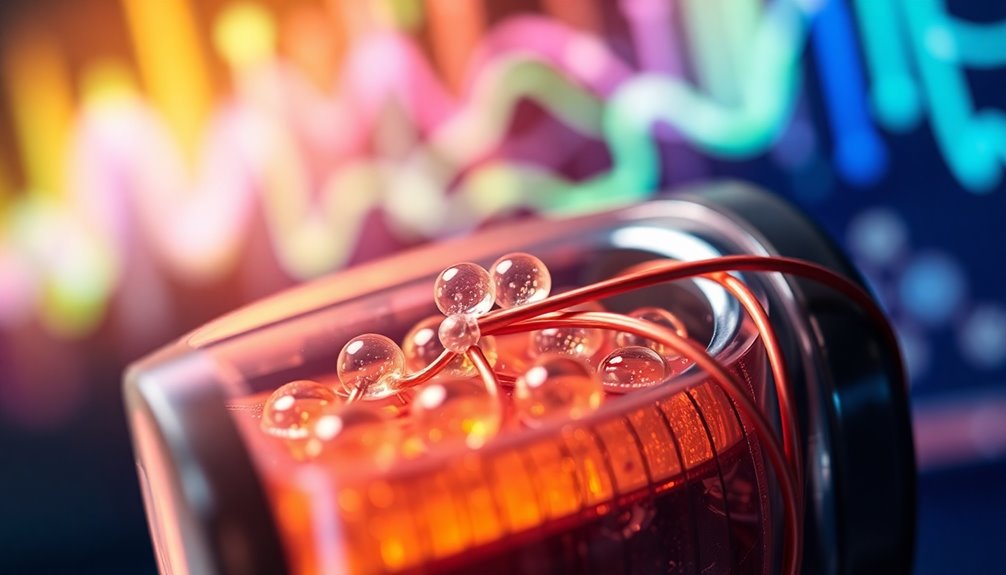
When it comes to battery performance, temperature plays a vital role in how efficiently they operate.
You'll notice that high heat can lead to faster degradation, while the rate at which you discharge energy directly affects capacity.
Understanding these factors, along with the effects of aging, can help you maximize your battery life and efficiency.
Temperature Effects on Performance
While you may not think about it often, temperature plays an essential role in battery performance. Extreme temperatures can hinder efficiency, impacting your device's reliability.
Here are three key effects you should know:
- High Temperatures: Excessive heat can increase self-discharge rates and shorten your battery's lifespan.
- Low Temperatures: Cold conditions slow down chemical reactions, causing a 20-50% reduction in usable energy.
- Optimal Range: Keeping your battery between 20°C to 25°C (68°F to 77°F) guarantees maximum efficiency and longevity.
To protect your battery, store it in a cool, dry environment. This simple step can help mitigate temperature fluctuations and improve overall performance, keeping your devices running smoothly.
Discharge Rate Impacts Capacity
Understanding how discharge rates impact battery capacity is crucial for maximizing performance in your devices. The discharge rate determines how quickly a battery releases its stored energy, greatly influencing its overall effectiveness. Higher discharge rates increase internal resistance, which can lower effective capacity and voltage output. For example, a lithium-ion battery designed for low discharge might only deliver 80% of its nominal capacity when subjected to high rates. This reduction in sustained power can affect devices demanding consistent energy flow. Properly managing these rates is essential for enhancing battery lifespan and ensuring reliable performance.
| Discharge Rate | Capacity (%) | Voltage Output |
|---|---|---|
| Low (0.5C) | 100 | Stable |
| Moderate (1C) | 90 | Slight decline |
| High (2C) | 80 | Significant drop |
| Very High (5C) | 60 | Critical drop |
Aging and Efficiency Decline
Batteries naturally degrade over time due to ongoing chemical reactions, leading to a decline in capacity and efficiency. Several factors contribute to this aging process:
- High discharge rates: They accelerate aging, diminishing performance and shortening the battery's lifespan.
- Extreme temperatures: These can cause irreversible damage, drastically affecting efficiency and longevity.
- Cycle life: The number of charge-discharge cycles a battery can undergo before significant capacity loss is vital for overall efficiency.
To combat these effects, regular maintenance and proper storage conditions are essential.
By managing how you use and store your batteries, you can help maintain their performance and extend their operational life.
Understanding these factors will empower you to make informed choices about your battery usage.
Innovations and Environmental Impact

As innovations in battery technology continue to evolve, researchers are focusing on solutions that enhance performance and mitigate environmental concerns. Solid-state batteries are gaining attention for their higher energy density and improved safety over traditional lithium-ion options.
You'll also appreciate the development of fast-charging technologies, allowing batteries to charge quickly without overheating, making them more convenient for your daily use.
Moreover, advances in recycling methods are vital for lowering the environmental footprint of batteries by reclaiming valuable materials and cutting down e-waste.
As the extraction of lithium and cobalt raises significant environmental issues, sustainable sourcing practices are becoming essential.
Finally, lifecycle analysis is helping assess the environmental impacts from production to disposal, fostering better industry regulations and practices.
Frequently Asked Questions
How Does Battery Work Scientifically?
When you think about how a battery works scientifically, it's all about chemical reactions.
You've got two electrodes—the anode and cathode—where oxidation and reduction happen. The anode releases electrons, while the cathode accepts them, creating a flow of electricity.
A separator keeps these parts apart to prevent short circuits, but it allows ions to move through the electrolyte.
Factors like temperature and discharge rate can influence the battery's efficiency and performance.
What Is the Chemistry Behind Batteries?
The chemistry behind batteries involves electrochemical reactions, where oxidation and reduction occur at the electrodes.
When you use a battery, the anode loses electrons, while the cathode gains them, generating an electric current.
An electrolyte, either liquid or gel-like, allows ions to move between the electrodes, vital for these reactions.
A separator keeps the anode and cathode apart to prevent short circuits while still permitting ionic movement, ensuring efficient energy conversion.
What Is the Detailed Explanation of Batteries?
Imagine charging your phone with a potato—batteries function on a similar principle!
They consist of electrodes, an electrolyte, and a separator that transform chemical energy into electrical energy. When you connect a battery, electrochemical reactions occur, moving electrons from the anode to the cathode, creating a current.
You've got two types: primary batteries that can't be recharged, and secondary batteries that can.
Factors like temperature and discharge rate affect their performance and lifespan.
What Is the Purpose of the Battery in the Experiment?
The purpose of the battery in your experiment is to provide stored chemical energy that gets converted into electrical energy to power the circuit.
You'll notice that batteries create a charge difference, with positive and negative sides driving the flow of electrons when connected.
As the battery discharges, it enables devices like LEDs to function.
If the battery depletes, it won't produce enough voltage, leading to non-functional devices in your setup.
Conclusion
Now that you've dived into the world of batteries, you might be wondering how these little powerhouses impact your daily life. From keeping your devices running to driving innovations in renewable energy, batteries play an essential role. Understanding their anatomy and function can help you troubleshoot issues and make informed choices about rechargeable versus nonrechargeable options. So, the next time you power up your gadget, ask yourself: how much do you really rely on these amazing inventions?

